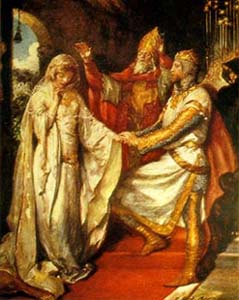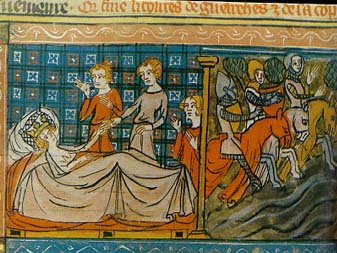Cats, cats, cats...
History...
Useful pages...
Sign My
Guestbook
View My
Guestbook

|
|
Kindly supplied by: http://www.eliki.com visit this link to learn more about
Camelot.
See below for books on Guinevere.

Arthur's marriage to Guinevere established his court. As her dowry,
Guinevere brought the legendary Round Table and the royal couple became the center of the
glittering circle of the chivalric knights. |
Guinevere's heritage varies according to different legends. According to Malory,
Guinevere (in Welsh, Gwenhwyvar which means 'White Phantom') was the daughter of King
Leodegrance of Cameliarde. In Welsh tradition, her father is called Gogrvan or Ocvran. In
Thelwall's play The Fairy of the Lake (1801), it is suggested she is the daughter
of Vortigern. In some stories, she had a sister named Gwenhwyvach, and a French legend
tells of an identical twin sister called Guinevere the False. In yet another tale, she had
a brother called Gotegrin.
Once Arthur was firmly established on the throne, and despite Merlin's warnings she would
one day betray him, Arthur chose Guinevere, to become his wife. As a dowry she brought the
great round table capable of seating one hundred and fifty knights, made by Merlin at the
bidding of Arthur's father, Uther Pendragon.
In Gawain and the Green Knight, it is stated the reason Morgan le Fay sent the
Green Knight to Camelot was to frighten Guinevere. One reason given was because of an old
rivalry, dating back to the beginning of Arthur's reign when Guinevere had banished one of
Morgan's lovers from court. Another reason is the representation of Guinevere and Morgan
as two goddesses of very different aspect. Morgan, as her origin in the figure of
Morrighan indicates, is a dark goddess and represents the powerful qualities of winter and
warfare. On the other hand, Guinevere is called the Flower Bride, representing spring and
the unfolding of life. As such, these two women are constantly in opposition. Lancelot,
Guinevere's champion, becomes the bitter foe of Gawain, who is Knight of the Goddess -
Morgan's champion. |

When the Arthurian legends were reworked by Christian writers,
both Guinevere, the goddess of flowers and light, and Morgan,
the Dark Goddess, spent time in a nunnery. |
As the Flower Bride, myth calls for Guinevere to be stolen away by one of her
suitors and then to be rescued by another representing shifting polarities with the change
of seasons. An example of this role is told in the Life of Gildas, by Caradoc of
Llancarfan. In this text, Melwas of the Summer Country carried off Guinevere and she was
then rescued by Arthur. The abduction scene reappears in several stories where the
kidnapper is Meliagraunce, a knight desirous of Guinevere. In this tale, the rescuer is
Lancelot rather than Arthur.
Eventually, she and Sir Lancelot fall in love. In one tale, the False Guinevere takes
Guinevere's place while she takes refuge with Lancelot in Sorelois. The False Guinevere
and her champion Bertholai finally admit their deception and after the False Guinevere's
death, the true Guinevere is restored to Arthur. By this time, Guinevere and Lancelot are
irrevocably in love and Lancelot's struggle with his conscience keeps him away from
Camelot pursuing quests. Just when Guinevere and Lancelot came to the decision to end
their affair for the good of the kingdom, Mordred, Arthur's illegitimate son, captured
them in the queen's chamber. Lancelot fled and Mordred forced Arthur to condemn Guinevere
to the stake. Lancelot rescued her but in the process accidentally killed Gareth and
Gaheris, Gawain's brothers, and a war ensued. While Arthur was away fighting Lancelot,
Mordred declared his father dead and proclaimed himself king and announced Guinevere will
become his wife. She refused and locked herself in the Tower of London. Arthur returned to
fight yet another war against Mordred and received a mortal wound in battle.

Guinevere sends her ring to Lancelot, medieval manuscript
|
Following the death of Arthur, Guinevere entered a nunnery at Amesbury and stayed there
until her death. A different tale according to Perlesvaus, says she died as a
prisoner of the Picts. At her death, she was laid to rest beside Arthur.
It has been argued Guinevere is a mythical figure representing the sovereignty of Britain
over which would be rulers battle. In this respect she is a figure similar to Eriu, the
goddess of the sovereignty of Ireland. As well as the Flower Bride, Guinevere represents
the Sorrowful Queen or the Wounded Lady who suffers the burden of evil acts carried out in
ignorance of love in Arthur's kingdom.
|
|